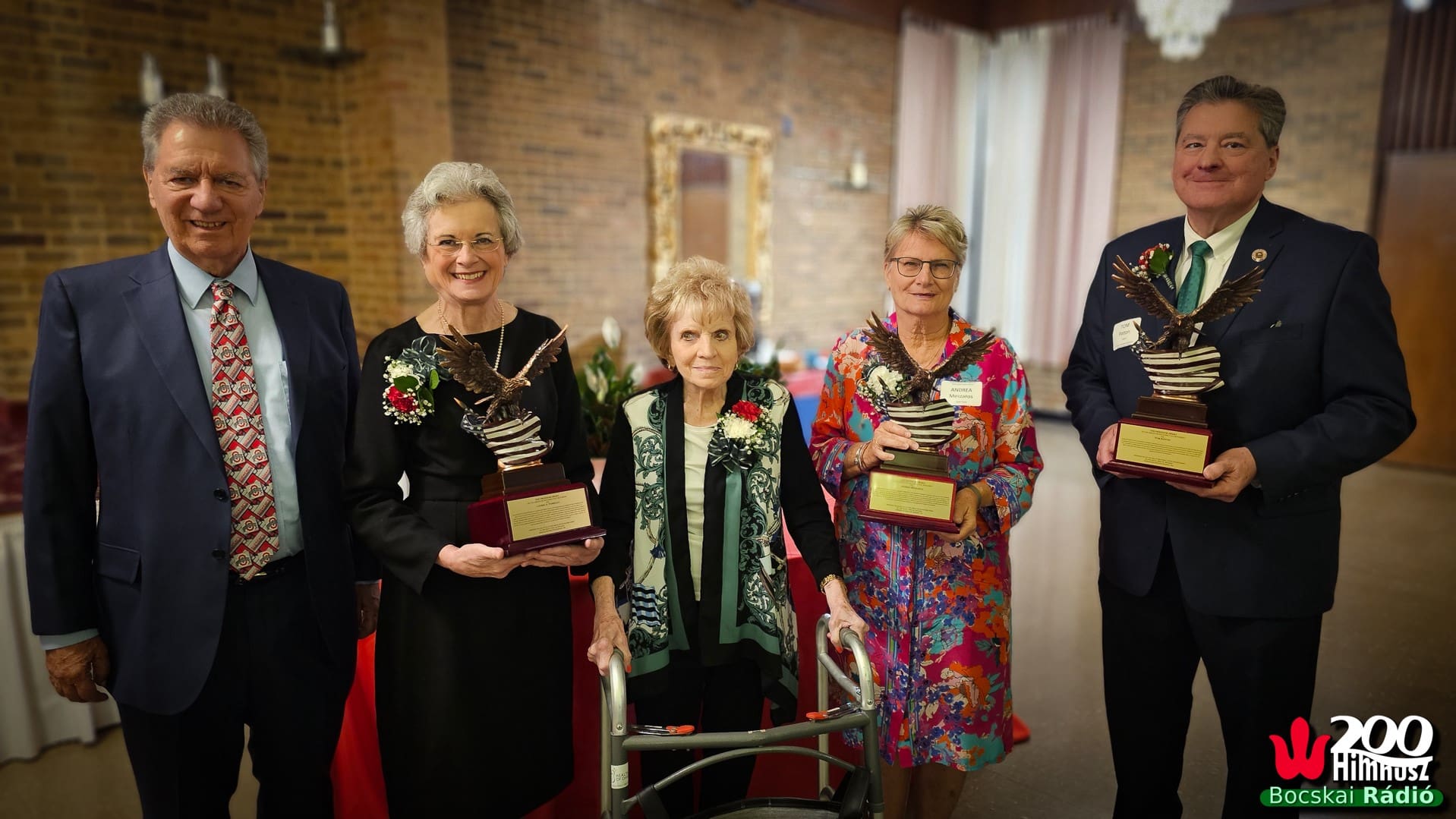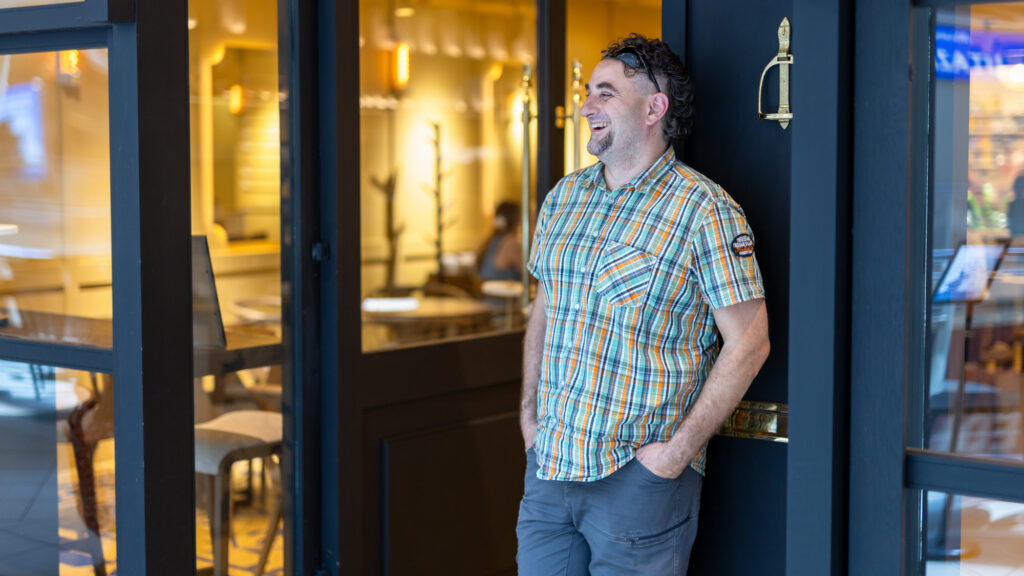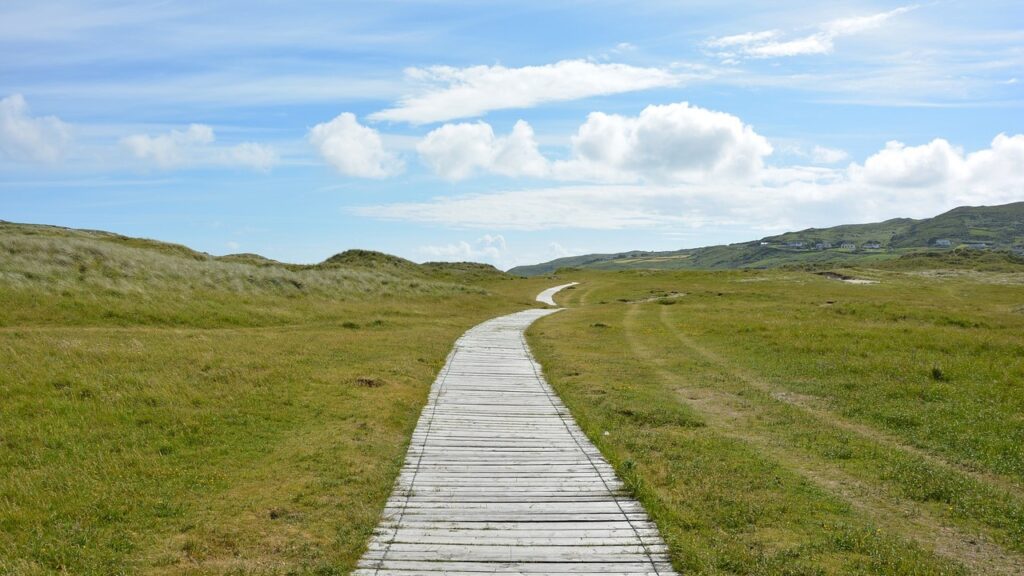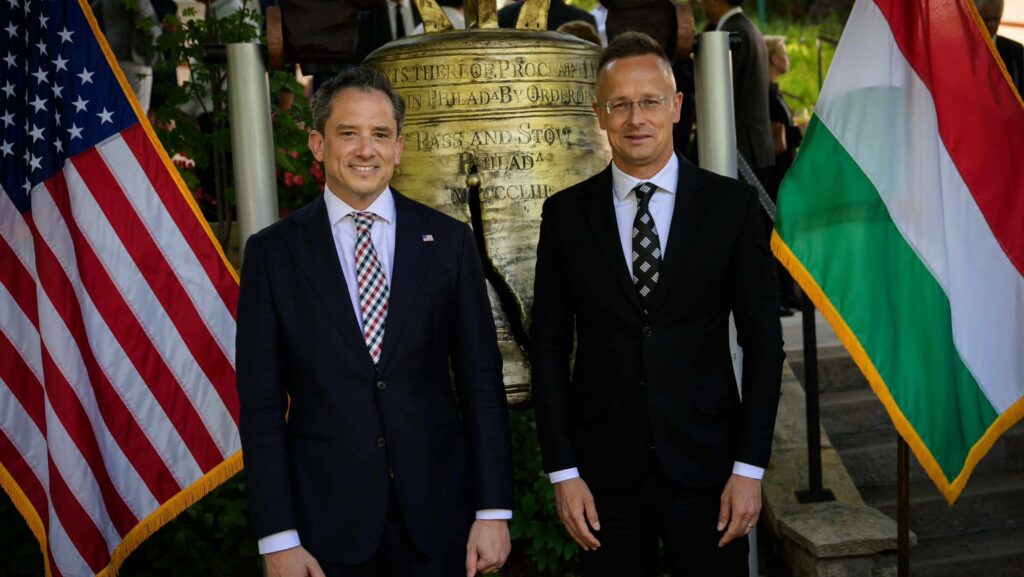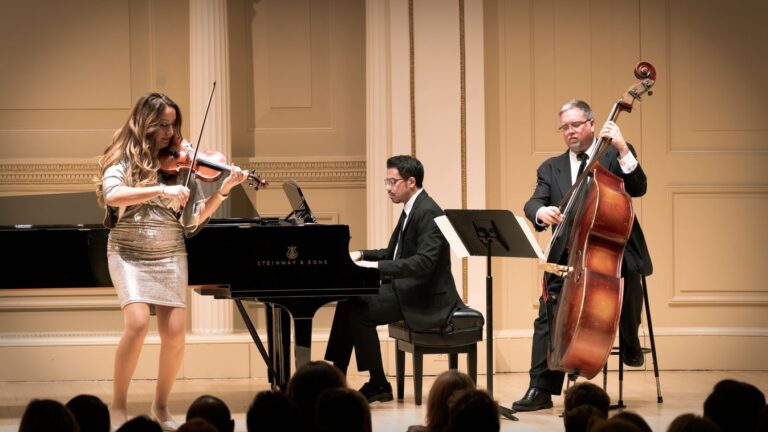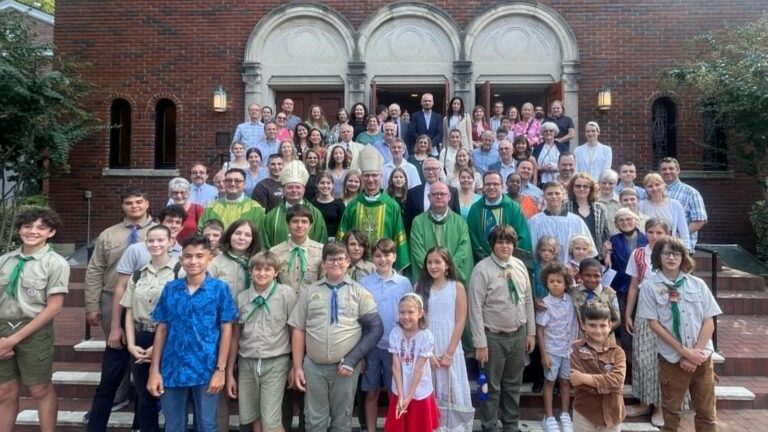Born in Virginia, Andrea came to Cleveland at the age of six, where she became an active member of the Hungarian community following in the footsteps of her parents. She was the leader of the local girl scout troop, later district commissioner and today is still an active adult scout. She was president, vice president, and currently is a board member of the local Hungarian Heritage Museum, and recently became president of the United Hungarian Societies. Her eleven grandchildren live far away, but she keeps in touch with all of them in Hungarian.
***
How did you end up in Cleveland?
My father graduated as a doctor from the University of Debrecen in 1943 and was immediately taken to the Russian frontlines in WWII, where he served as a physician. The military hospital where he worked was withdrawn to Hungary toward the end of the war, but then moved further west by train as far as Bavaria. My mother, who at the time was a fresh graduate from high school, worked as a nurse on the same train. They married in Neuburg as American prisoners of war and arrived in the US in December 1950 when my mother was already pregnant with me. While they never met in person, my father was sponsored by a Jewish doctor of Hungarian descent. I was born in Norfolk, Virginia and spent my first six years there. Most of my parents’ friends lived in Cleveland though. My father was lucky when a Cleveland hospital needed a pathologist. We arrived in the late summer of 1957 and I started elementary school.
Do you have any memories of your first six years in Virginia?
I remember the beautiful Easter holidays; spring is wonderful down there. We used to go to Williamsburg after the Easter Sunday mass and spent the day there. I also remember when my parents and my godparents became US citizens in a ceremony in Jamestown, the first permanent English settlement in North America. They traveled to Washington DC in 1956 to join the Hungarians protesting Russian oppression. There were two or three other Hungarian families living in Norfolk, so all in all, we were a very tiny Hungarian colony, but we had a clear sense of Hungarian identity and community. My mother would call her best friend every afternoon at 3 o’clock to speak Hungarian for half an hour and then German for half an hour, so that they wouldn’t forget these languages. I was first introduced to American children when my mother started working and I went to kindergarten. I also remember the terribly hot and very humid air. My father was from Zemplén and Szabolcs counties and my mother from Miskolc, so they were used to the heat, but the humidity in Virgina was very difficult for them. And finally, I remember that when friends from Cleveland visited, we would always go to Virginia Beach, which was a 30-minute drive from our house. I don’t have any bad memories, but I know that for my mother it was very difficult to live in a foreign country without her extended family. There was no telephone communication, and if you got a telegram, it was never good news. Everyone left parts of their families in Hungary and everyone was worried about them. It was good for my parents to move to Cleveland because they didn’t feel so isolated here. Since they came in 1957, a lot of people thought they were 56ers.
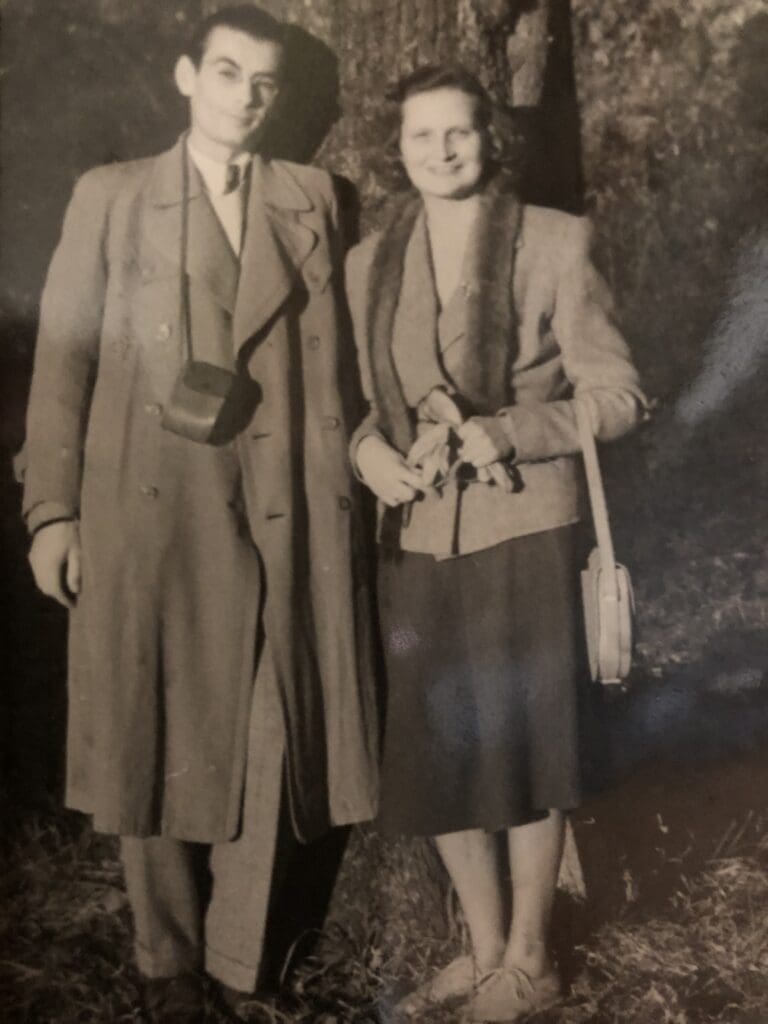
Your parents quickly became part of Hungarian life in Cleveland, and so did you.
My brother as well, who was born here. Living in the Hungarian community in Cleveland has always been a good experience. My mother had friends from her hometown, my father had them from high school, and both had quite a few friends from Germany. There were Hungarian neighborhoods on both sides of town. The Buckeye Road neighborhood was very vibrant. I remember many Saturdays when we went shopping at the Hungarian butcher, the baker, the import store, the scout store…My father was a very committed scout, so he quickly became the local scoutmaster, and my mother supported him. If it was needed to cook plum dumplings for all the bachelors, it was my mother, and my father was the one who took a week off from his three-week vacation to cook for his troop at the scout camp. He first introduced me to scouting in 1958 and I’ve been scouting ever since. There were a lot of scouts in Cleveland at that time; several hundred altogether in four troops. There are fewer of us now, but the scout movement is just as vibrant as it was then. I became troop leader of Girl Scout Troop 33 in 1976 and led them until 1982. I remained very active as a scout parent, and after my children grew up, I was Cleveland District Commissioner for seven years. The area I served included Chicago and Buffalo in addition to Cleveland. I am a member of the Board of Directors and a legal advisor for the American Hungarian Friends of Scouting in addition to being a member of Troop 33, which is now an adult troop, and its main mission is charitable support for fellow Hungarians.
In more than ten years, we have sent hundreds of pounds of durable goods to Hungarians in Rahó, Transcarpathia,
spending thousands of dollars on shipping. We volunteer at the Hungarian Scout Festival and various other scouting events. I have also been teaching at the summer school camp of the Hungarian Scout Association in Exteris.
Before we move onto your community service roles; when and how did you have a family?
Elemér was already part of the Hungarian community when we arrived in Cleveland. I got to know him better in 1974, when Cardinal Mindszenty came to visit Cleveland. We had known each other before, we were in the same social group, scouting, volunteering and socializing. We got married in 1980 and have three children: Michael is an architect and father of four in Washington DC; Krisztina works in the financial sector, lives in Chicago and has three young sons. Andrew teaches theology at a university in Ireland and is the father of four. So we have eleven grandchildren, with only one Hungarian parent, but they all speak some Hungarian.
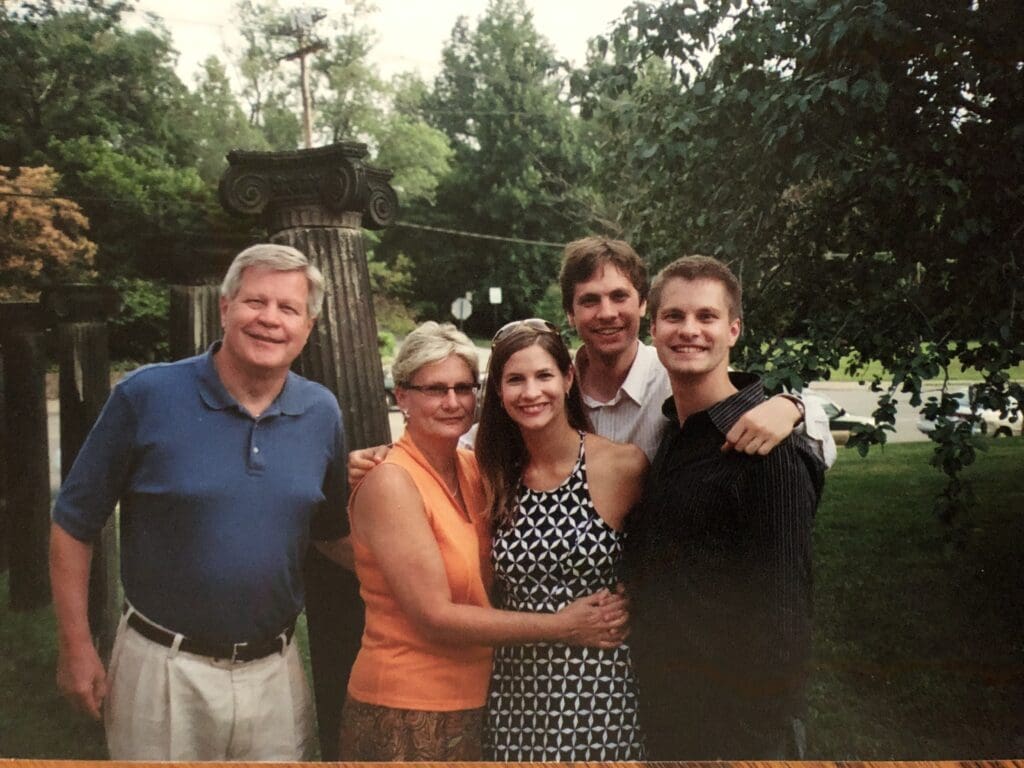
You are a board member of the Cleveland Hungarian Museum, but you have also been vice president and president there. How did you get there?
The original idea of the Museum came from Father Nyeste, who served as St. Elizabeth Church’s pastor, and this was one of his dreams. Someone put him in touch with Otto Friedrich, who also had this dream and had already collected various items of historical significance. The two of them gathered further people around them to work establishing a museum. I was present at those meetings in the mid-1980s and was asked to draft and submit the articles of incorporation, and then to draft the bylaws for the Cleveland Hungarian Heritage Society At that time, I was still busy as a scout parent and attending leadership training camps, where I took the children with me, so I didn’t take on any other tasks at the museum. Dr. Ferenc Somogyi, a widely liked and respected member of our community was our first president. My husband followed him. Otto’s wife, Mária was also president, and when she became ill, then vice president Steve Szappanos took over. I first volunteered at the gift shop, later at the museum as a docent (a guide), showing visitors around. In 2006 ‘Pistaba’ asked me to take over the presidency. The Museum was well run by then: everybody did their job. This is still the case today: dr. Klára Papp is the head of the program committee, Mary Jane Molnár runs the gift shop, András Lázár is in charge of exhibitions, Andrea Lázár is our publicity head, my sister-in-law, Magdolna Mészáros manages the library, and Marika Zsula manages the volunteers. And finally, there is my husband, who manages the museum’s investments. We are open three days a week.
What kind of programs are offered in the museum?
We have monthly programs in the spring and autumn. During and after the Covid pandemic, we held these via Zoom calls. On the 100th anniversary of Trianon, historian András Ludányi gave a fantastic online lecture on the background of the peace decree. Last May we revived the Pilvax Café; in February dr. Krisztina Fehér, teacher at Cleveland State University, talked about Hungarian dialects; in March dr. Pál Gyékényesi will talk about his role in expanding soccer in the U.S. In May Zoltán Csadi, living in Toronto as a Kőrösi Csoma Sándor Program (KCSP) scholar of the Rákóczi Foundation, will talk about the history of Budapest theaters. Most of our performances and lectures are held in English, because a large percentage of the museum’s membership and supporters are third–fourth generation Hungarians, who identify as Hungarians, but don’t speak Hungarian. In addition, we started a children’s program: Saint Nicholas visits us each year. About 30–35 children plus parents and grandparents visit us on these occasions. My goal is to always teach them, especially children who don’t go to Hungarian schools or scouting, but their parents want them to belong to this community, to see Hungarian folk costumes, hear folk music and play folk games. Finally, my husband came up with the idea of a wine tasting fundraising dinner 27 years ago and he is still involved in it. We have recently been working with Taste Hungary, a company in Washington DC that imports Hungarian wines. Those who can’t attend the event, but would like to donate, receive wine as a gift via mail. Those who participate have a great dinner with fantastic wine and enjoy fine Hungarian music by Harmónia.
What about the exhibitions and the library?
We have a permanent exhibition beginning with the arrival of the Hungarians to the Carpathian basin to the present, including the history of Cleveland’s Hungarian immigrant community, since visitors from Hungary and elsewhere are interested in understanding how the Hungarian community evolved here. The temporary exhibition space features the art of József Domján’s artist wife, Evelyn. The material on exhibit is borrowed from her son who lives in Texas. In addition, one of our most beautiful and precious items is a Herend replica of the Hungarian Holy Crown. Our library has over 8,000 volumes; newspapers, magazines, books in Hungarian and English on various subjects: fine arts, history, language and literature, poetry, cookbooks. There is a very unique part, too: Hungarian emigré poetry, writings, novels, journals, newspapers, all the chronicles of the Hungarian Association, copies of the Hungarian scout magazine, and various studies about the local Hungarian community. This is not a lending library, but a research library. The library’s archives also include a very rich collection of materials.
Let’s turn to your recent position as president of the United Hungarian Societies (UHS).
UHS is an old Hungarian initiative, founded in 1902. From the original documents it is clear that its aim was to create an umbrella organization to which all Hungarian community clubs and associations could belong. At its peak, there were over fifty member associations; now there are fifteen, plus six churches and a shrine. UHS is responsible for organizing celebratory events for the two Hungarian national holidays and two other commemorations: March 15, October 23, Heroes’ Day, and the Kossuth Commemoration. Former president Endre Szenkirályi asked me to take over the presidency and assured me that it wouldn’t be too difficult to organize four events a year. I accepted the position for a term of two years. Loránd Csibi is the vice president; Petra László is the secretary, József Földesi became the treasurer, Endre is our recording secretary, Richárd Sárosi and Tas Nádas are the controllers. I am happy that we have some younger officers. In addition, UHS represents the Hungarian community in Cleveland vis-a-vis the US and Hungarian governments. Yesterday we listened to a presentation by Deputy State Secretary Dr. Péter Szilágyi on various scholarship programs intended for the Diaspora. When a letter of public interest arrives from the Hungarian Embassy or Hungary, it usually goes first to the UHS president, who forwards it to the member organizations, who then circulate it to their own members.
Will this year’s 15th of March celebrations be different from previous years?
We alternate the commemorations of the two national holidays among the churches, because unfortunately there is no Hungarian house or center in Cleveland. We have a park, a scout center, many churches and organizations, but unfortunately no Hungarian House.
This year the 15th of March commemoration will be held at the Lutheran church.
I have been very lucky to have János Szabó, one of our current KCSP scholars, who volunteered to organize the program. There will be dramatizations, recitations, choral singing and solo performances of lesser known Kossuth songs. It will be a rich program. This program will embrace the end of the revolution; despite the fact that the 1848 Revolution was a losing effort, to a certain extent the Hungarian consciousness and national pride that was built up and flourished during the fight for independence in 1848–49 still exists today. Since I’ve heard several requests that we include in our program members of the Hungarian community who trace their heritage back three to four generations and no longer speak the language, two young Hungarian American college students will share brief remarks in English about what their Hungarian identity means to them. There are two Hungarian flags at Cleveland City Hall: the 1956 flag with the well-known hole in the middle and the 1948 flag, and they already know which one to put up in March and which one in October.
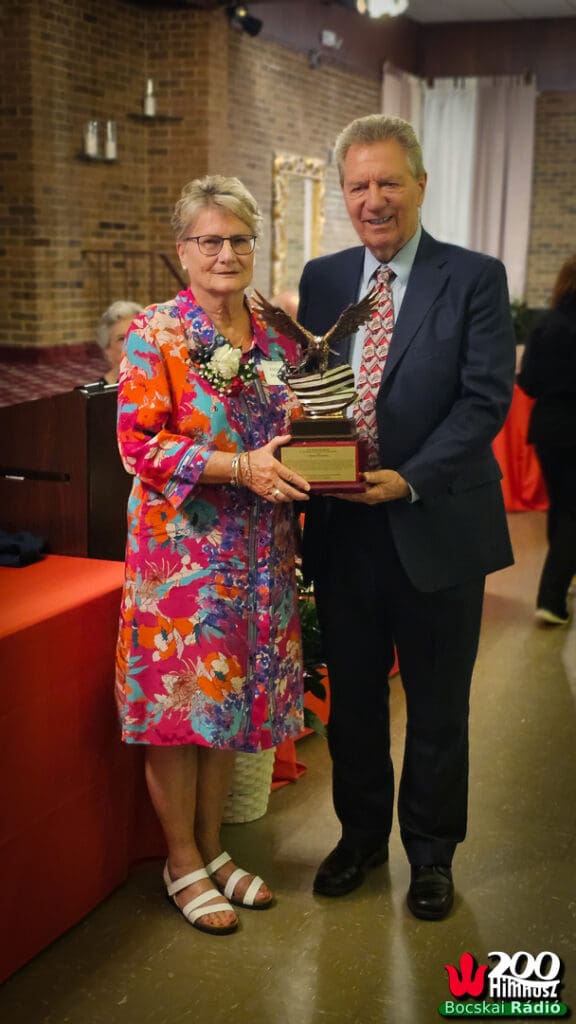
You recently received the Freedom Award from a non-Hungarian community in Cleveland. At the awards gala, you stated: it is worthwhile to involve children in the community as soon as possible. When you took over the UHS presidency, you said: it is a great responsibility to ensure that people of different habits can work together and are all guided by a common goal.
The Freedom Award was given by the American Nationalities Movement for my activities in scouting and the Hungarian Museum. This organization was founded in the 1950s, and at that time it included new immigrants living in Cleveland from countries that suffered under communism.
Now their circle has expanded to many nationalities living in the Cleveland area, for example Syrians, Lebanese, Vietnamese. I am thankful to my parents for involving me in the Hungarian community in Cleveland at an early age. I am also grateful to my husband, because it certainly matters a lot if you don’t have to fight at home to ‘do Hungarian stuff’. We have always been active and supported each other’s work. And finally, the community itself is very important. In my experience, when doing community work, you don’t have to agree with each other, but you should never get personal or be offended. Some people can do this better than others. I generally like people and working with them, and even if there is some kind of tension with someone, I never let it spoil our relationship and our work. We have been here in Cleveland for too long and so many generations have arrived over so many years that I think most people have realized the dangers of non-cooperation. If we want some kind of Hungarian community life to exist here on the shores of Lake Erie 30, 40, 50 years from now, then it would be better to overlook religious differences or whether we can speak or not speak Hungarian or if we have different political views. If we can put all these aside, then the Cleveland Hungarian cart can move forward; but if we get bogged down by these differences, the cart will run into mud, and as we say, not even six oxen will be enough to pull it out from this quagmire. I think the newer generations fortunately understand this a bit better than the earlier ones did.

